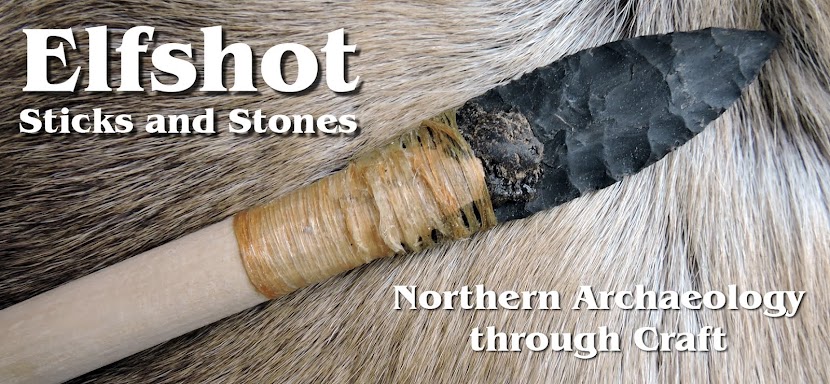 |
| Winding the thong to stretch |
I'm really trying to get back into a normal spring work routine again after last week's seal excitement. I did make a brief visit to the workshop yesterday, but mostly I've been getting caught up on e-mails and paperwork. There have also been a few small seal related projects on the side. I've mentioned the skin, intestines, and bladder, but I'm also saving some of the blood, blubber, and oil.
 |
| Seal Blood Cube Trays |
Blood: Seal blood makes a good glue and this is my first chance to work with it. I tried it briefly on the endscrapers when they came loose in the handles, but I don't believe I let the glue set long enough to really give it a chance. In an attempt to preserve it, I've filled two mini-ice cube trays with about a cup of blood. This should give me good portion control so that I can thaw out as much or as little as I need.
 |
| Seal blood glue drying |
I'm especially interested in seeing how it works with baleen. Hide glue works great with sinew and dries invisibly, but on baleen it creates a messy coating. I hope the darker blood glue will stick as well and create a more cohesive appearance.
 |
| Frozen seal fat |
Blubber: We saved a few ziploc bags full of the fat and put them in the freezer. I want to use it for soapstone lamps, so we separated it into sandwich bag sized portions that can be thawed out as we need them.
I'll take a big bag into The Rooms on Sunday so that they can have it on hand for the lamps that I've made for them in the past.
 |
| Palaeoeskimo soapstone lamp reproduction |
 |
| Bagging blubber |
Oil: I didn't think about collecting the oil until it was almost too late. I had planned to render some of the fat into oil, but for some reason it didn't occur to me until after the scraping was over to just collect some of the liquid oil that we spent 3 days pressing out of the skin. I bottled a small amount to experiment with as a base for mixing red ochre paint. Right now, my favourite red ochre paint recipe uses linseed oil, eggs, and water. I'd like to try substituting seal, caribou, and fish oil for the linseed oil.
 |
| Hooded seal oil |
The Beothuk mixed their red ochre with caribou grease and Newfoundlanders made big buckets of red paint for their buildings out of seal oil and ochre. I want to start experimenting with seal oil paint on some of my reproductions.
 |
| The bladder is drying nicely |
Right now everything is collected, bottled or bagged, frozen or drying and I just need to keep and eye on it all over the next few days and weeks. The intestines and bladder are starting to go translucent and have turned from pink to amber. The skin is still greasy, but its getting dryer to the touch.
Today, I need to work on knapping Recent Indian arrowheads for necklaces and this evening I have a demonstration for the staff who work in all the
Historic Sites Association's Heritage Shops at National Parks around the province. I think I'll take in reproductions that we used on the seal. They've been cleaned up, but I think they'll still be identifiable by scent.
Photo Credits:
1,6: John Erwin
2-5,7,8: Tim Rast









No comments:
Post a Comment